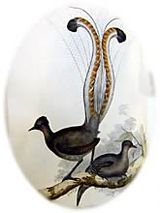|
Passeri |

Superb Lyrebird
as painted by
John Gould
of a British Museum specimen
( in real life, the Lyrebird's tail is different
)
|
|
Scientific classification |
| Kingdom: |
Animalia
|
| Phylum: |
Chordata
|
| Class: |
Aves
|
| Order: |
Passeriformes
|
| Suborder: |
Passeri
|
|
| Families |
|
Many, see text |
A songbird or oscine is a
bird belonging to the suborder Passeri of
Passeriformes (ca. 4000 species), in which the vocal
organ is developed in such a way as to produce various sound
notes, commonly known as bird song. Songbirds evolved about
50 million years ago in the western part of Gondwana that
later became Australia, New Zealand and Antarctica and later spread around the world.
This 'bird song' is essentially territorial in that it
communicates the identity and whereabouts of an individual
to other birds and also signals sexual intentions. It is not
to be confused with bird calls which are used for alarms and
contact, and are especially important in birds that feed or
migrate in flocks.
Other birds have songs to attract mates or hold
territory, but these are usually simple and repetitive,
lacking the variety of many passerine songs. The monotonous
repetition of the Common Cuckoo or Little Crake can be
contrasted with the variety of a Nightingale or Marsh
Warbler.
Although many songbirds have songs which are pleasant to
the human ear, this is not invariably the case. Many members
of the
crow family make croaks or screeches which sound harsh
to humans.
Under the
Sibley-Ahlquist taxonomy this suborder is divided into
two parvorders,
Corvida and
Passerida. However, more recent research is casting
doubt on the existence of Corvida as single parvorder, but
given the present lack of any generally accepted redivision
of Corvida into two or more groupings at the parvorder
level, the families of suborder Passeri are listed below as
being in either Corvida or Passerida.
Families
- Menuridae: lyrebirds
Atrichornithidae: scrub birds
Climacteridae: Australian treecreepers
Maluridae: fairy-wrens, emu-wrens and grasswrens
Meliphagidae: honeyeaters and chats
Pardalotidae: pardalotes, scrubwrens, thornbills, and
gerygones
Petroicidae: Australian robins
Orthonychidae: logrunners
Pomatostomidae: Australasian babblers
Cinclosomatidae: whipbirds and allies
Neosittidae: sittellas
Pachycephalidae: whistlers, shrike-thrushes, pitohuis
and allies
Dicruridae: monarch flycatchers and allies
Campephagidae: cuckoo shrikes and trillers
Oriolidae: orioles and Figbird
Icteridae: American blackbirds, New World orioles,
grackles and cowbirds.
Artamidae: wood swallows, butcherbirds, currawongs and
Australian Magpie
Paradisaeidae: birds of paradise
Corvidae: crows, ravens, and jays
Corcoracidae: White-winged Chough and Apostlebird
Irenidae: fairy-bluebirds
Laniidae: shrikes
Vireonidae: vireos
Ptilonorhynchidae: bowerbirds
Turnagridae: Piopio
- Alaudidae: larks
Chloropseidae: leafbirds
Aegithinidae: ioras
Picathartidae: rockfowl
Bombycillidae: waxwings and allies
Ptilogonatidae: silky flycatchers
Cinclidae: dippers
Motacillidae: wagtails and pipits
Prunellidae: accentor
Melanocharitidae: berrypeckers and longbills
Paramythiidae: tit berrypecker and crested berrypeckers
Passeridae: true sparrows
Estrildidae: estrildid finches (waxbills, munias, etc)
Parulidae: New World warblers
Thraupidae: tanagers and allies
Peucedramidae: Olive Warbler
Fringillidae: true finches
Cardinalidae: cardinals
Drepanididae: Hawaiian honeycreepers
Emberizidae: buntings and American sparrows
Nectariniidae: sunbirds
Dicaeidae: flowerpeckers
Mimidae: mockingbirds and thrashers
Sittidae: nuthatches
Certhiidae: treecreepers
Troglodytidae: wrens
Polioptilidae: gnatcatchers
Paridae: tits, chickadees and titmice
Aegithalidae: long-tailed tits
Hirundinidae: swallows and martins
Regulidae: kinglets
Pycnonotidae: bulbuls
Sylviidae: Old World warblers
Hypocoliidae: Hypocolius
Cisticolidae: cisticolas and allies
Zosteropidae: White-eyes
Timaliidae: babblers
Muscicapidae: Old World flycatchers and chats
Turdidae: thrushes and allies
Sturnidae: starlings
See also
External link
-
Oscines Tree of Life web project article July 31,
2006




